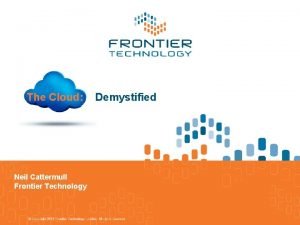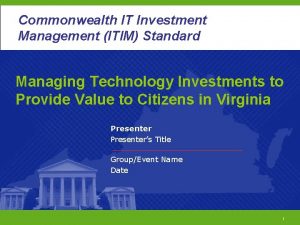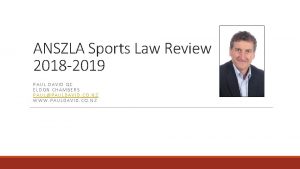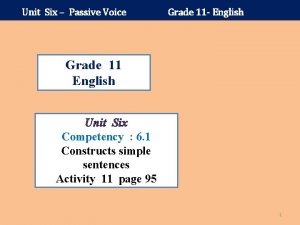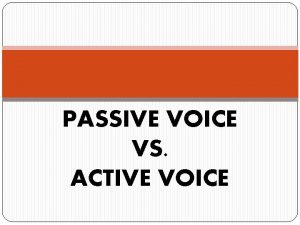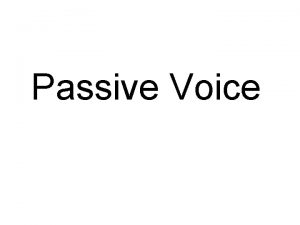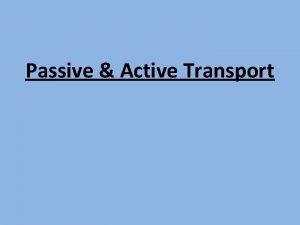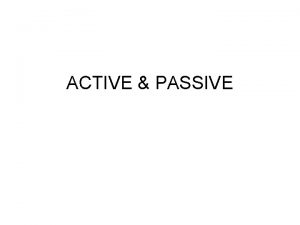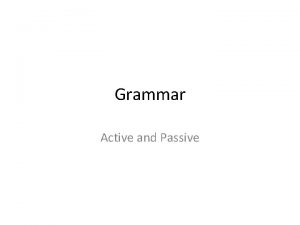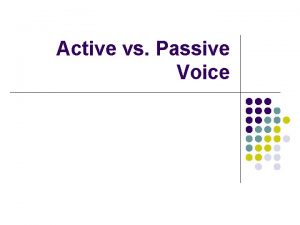Active management including passive funds Paul Cattermull David



















- Slides: 19

Active management including passive funds Paul Cattermull David Myrddin-Evans Director, Charity Team 1

In the Passive “Camp” Press Financial Times, May 29, 2016 ETF Strategy, Feb 3, 2017 Financial Times, April 2, 2017 Financial Times, 2017 www. stock-trkr. co. uk April 17, 2017 2

From the Active Press Money. Sense-15 Apr 2017 Financial News - 4 Jan 2017 Financial Times, December 20, 2016 Nex. Chang e 15 Apr 201 7 2017 lk-28 Apr Value. Wa 3

There are lots of questions posed… Why is there such a debate presently and should I take notice? What are the pros and cons of each approach? − − − Asset allocation Relevance Cost Style Market timing How can I address it for my charity and what are my options as a trustee? What is the regulator's view? What are the cost differentials between the active and passive approaches and can I save my charity money? Does a one size fits all approach work? How efficient are passive strategies? My charity's investment manager is an active fund manager. Should I believe the argument he makes, or is he fighting a rearguard action in the face of significant market change? Do the fund flow numbers lie or is there more than meets the eye? Are markets efficient; do passive strategies do it all? 4

The regulatory context Ø Recent FCA study – Asset Management Market Study (November 2016) • The FCA study supports the view that the average active fund manager does not outperform their relevant benchmark after costs • Most active managers are charging active fees for closet index management • The regulator also finally shone a light on the Investment Consultant market which had never previously come under their scope 5

Market trends are pushing assets away from traditional “Core Active” products… AUM 2015 NNB 2012 -15 Specialty Active 1 $5. 0 tr $450 bn $4. 8 tr $1, 100 bn Core Active 2 $4. 3 tr ($390 bn) $1. 6 tr $110 bn ETFs/Index $4. 3 tr $1, 375 bn $1. 1 tr $350 bn Source: Black. Rock, ETF and Index Mutual Fund 101, 2017 1 Specialty Active – includes multi-asset, retail alternatives and all active fixed income and equity products not included in Core Active. 2 Core Active – US: large/mid/small cap equity funds and core Fixed Income & Municipals. Europe: core developed market equity and fixed income mutual fund. AUM – Assets Under Management Source: Simfund. Data excludes money market funds and FOF’s, includes cross-border and EMEA domestic market mutual funds. NNB – Net New Business 6

The Sage of Omaha – truly active or closet passive? In his 2013 letter to shareholders, Warren Buffett uncovered his investment advice to a Trustee regarding his cash bequest to his wife as follows; “My advice to the trustee couldn't be more simple: Put 10% of the cash in short-term government bonds and 90% in a very low-cost S&P 500 index fund. (I suggest Vanguard's. ) I believe the trust's long -term results from this policy will be superior to those attained by most investors — whether pension funds, institutions or individuals — who employ high-fee managers. ” 7

Efficient Markets Hypothesis; developed by Eugene Fama in 1960 s Ø It is impossible to “beat the market” over the long term, except by chance Ø Market prices already incorporate and reflect all available information Ø Stocks always trade at their fair value, thus it is impossible to purchase undervalued stocks or sell stocks for inflated prices 8

Market efficiency Efficient Inefficient Ø Highly researched & liquid Ø Less researched & more volatile Ø Offer little opportunity to add value Ø Assets under or over priced by investors Ø Examples include - US large caps US Treasury market Currency markets - UK small caps Emerging Markets Alternatives 9

Characteristics of active investment management The benefits The risks / disadvantages Opportunity to outperform Cost • aim to beat the index • potentially higher returns than the average • often higher fees charged • cost associated with buying and selling investments Research insights Subjective • quality research possible • everyone has their own style • key man risk Choice • ability to avoiding certain securities and sectors • ability to gain exposure to specialist areas not covered passively • no guarantees on picking the winners 10

UK Equity active funds; the power of compounding and increasing the capital base Fidelity Special Values - 15. 26% pa; £ 100 invested turned into £ 214 Liontrust Special Situations - 13. 75% pa; £ 100 invested turned into £ 202 Majedie UK Equity – 10. 78% pa; £ 100 invested turned into £ 192 Axa Framlington UK Select – 9. 59% pa; £ 100 invested turned into £ 163 FTSE All Share index - 7. 8% pa; £ 100 invested turned into £ 135 Source; Bloomberg, capital returns, gross of fees. The above information is for illustrative purposes only and is not intended as investment advice. Past performance is not a guide to future performance. Performance is shown before charges which will have the effect of reducing the performance illustrated. 11

What exactly is passive management? Ø Belief in the Efficient Market Hypothesis Ø No need for stock selection or market timing – long term, buy-and-hold strategy Ø Style of management associated with index and exchange-traded funds (ETF) where a fund’s portfolio mirrors a market index Ø Low expense ratios Ø Two types: index (mutual) funds and exchange-traded funds Index Funds Exchange-traded Funds (Typically backed by real assets) (Typically derivative based) - - Developed in 1970 s Popular with retail investors - - Traded on fund platforms Larger minimum investment Simplicity Examples include Legal & General UK Index Trust HSBC FTSE 100 Index Fund Developed in 1993 – SPDR or ‘spiders’ Popular with institutional investors - Traded as stocks – margin & trading flexibility Flexibility with dealing in small sizes Alternative to using futures Examples include - Vanguard S&P 500 ETF i. Shares FTSE 100 ETF 12

Passive investment management characteristics The benefits The risks / disadvantages Diversification Market fall • hold all / representative sample of the securities in their target benchmarks • overall stock market (or bond prices) fall, so do index funds Low costs Limitations • generally lower fees and operating expenses • lack of flexibility • lack of engagement potential • one size fits all Simplicity Performance constraints • tracks an index, will not materially underperform • offers market exposure agility • rarely beat index return • forced to hold underperforming stocks • lack of asset allocation subtlety 13

Passive funds Source: Morningstar The above information is for illustrative purposes only and is not intended as investment advice. Past performance is not a guide to future performance. Performance is shown before charges which will have the effect of reducing the performance illustrated. 14

Trustee considerations Ø Trustees’ responsibility to act in the interest of beneficiaries − Risk appetite − Screening − Income − Time horizon − Engagement − Cost Ø Governance criteria cannot be pursued as easily through Passive Ø Duty to act with care and skill in responsibly managing of assets Ø Typically income and income growth important Ø Role of discretionary manager (professional advice, IPS, daily monitoring) 15

Getting the best of both worlds Ø This involves a blend of both active asset allocation and a mix of both active and passive fund selection meeting specific client objectives e. g. income, ethical and other restrictions Ø The investment process is designed to select actively managed investments that can add value to portfolios over the long term Ø Certain passive investments have a place in actively managed portfolios − efficient markets − cost benefits − cheap and agile tactical asset allocation Ø It is possible to identify a group of investment managers who can consistently outperform over the economic cycle after the costs of management Ø Not all successful managers can outperform every year Ø Active management provides an opportunity for engagement , encouraging good Governance 16

Benefits of blending active with passive Advantages Ø Opportunity to maintain performance objectives while staying aligned with asset allocation goals Ø Generally lower cost and possible tax efficiency Ø Can enhance income in line with objectives Ø Ability to control intended exposures and measure the effects of active positions Ø Exposure to areas where manager selection is difficult Ø Rebalancing portfolios can utilise both index and active investments Source: i. Shares by Black. Rock 17

Blending management pays Annualised performance to 30 June 2017 3 years 12 10 9. 6 5 years 12 9. 3 7. 6 7. 3 8 9. 1 8 6 4 4 2 2 0 0 Risk Profile 6 Benchmark 10. 2 10 6 Brewin Dolphin (median) 11. 4 ARC Steady Growth Teknometry Charity Universe Annualised performance to 30/06/17 % Discrete calendar year performance % 2012 2013 2014 2015 2016 YTD 1 year 3 years 5 years BD London Charity Team 14. 6 16. 6 4. 8 3. 0 16. 5 6. 7 20. 3 9. 6 11. 4 Composite Benchmark 10. 7 14. 0 7. 0 2. 2 17. 2 4. 5 14. 3 9. 3 10. 2 ARC Steady Growth 10. 5 14. 9 4. 4 2. 1 12. 6 4. 8 13. 9 7. 3 9. 1 Teknometry Charity Universe 11. 0 16. 1 4. 1 2. 1 13. 2 4. 9 14. 5 7. 6 9. 1 Highlighting long term performance of our balanced (Risk Profile 6) performance; this is a reasonable proxy for a passive balanced index (0. 2% pa management charges ). Source: Brewin Dolphin, ARC (www. assetrisk. com) and Teknometry. All figures are after underlying fund charges and are total return figures. ARC and Teknometry figures are net of management charges. Sample size: 100 funds, £ 495 million. The Composite Benchmark reflects Brewin Dolphin’s Risk Profile 6 (Moderate ). Past performance is not a guide to future performance. Performance is shown before fees which will have the effect of reducing the illustrated performance. The value of your investment or any income from it may fall and you may get back less than you invested. Portfolios may vary from that shown and therefore performance may vary accordingly. Performance figures cover the time that the team has been with Brewin Dolphin Ltd. 18

Conclusions Active vs Passive – old and stale debate, not cut and dried Ø Choice between active and passive is not based solely on performance; also risks investors want to take Ø Blending active and passive offers investors - Potential to generate benchmark beating performance with actively managed investments - Opportunity for enhanced risk management and cost efficiency through passive investments Ø Recognise and leverage the strengths of both for a blended solution • • • Lower costs Smooth volatility Potentially outperform benchmark Control exposures better Diversity across efficient and difficult to access markets 19
 Paul cattermull
Paul cattermull Neil cattermull
Neil cattermull Commonwealth funds management
Commonwealth funds management Esf+ regulation
Esf+ regulation Active high and active low
Active high and active low Membrane structures that function in active transport
Membrane structures that function in active transport Primary active transport vs secondary active transport
Primary active transport vs secondary active transport Superordinate subsumption example
Superordinate subsumption example Biografia ausubel
Biografia ausubel Paul david meesters
Paul david meesters Anszla
Anszla Active and passive listening
Active and passive listening Louise made the chocolate cake active or passive
Louise made the chocolate cake active or passive Let's
Let's Turn these sentences into the passive
Turn these sentences into the passive They introduced me to her husband passive voice
They introduced me to her husband passive voice Active or passive transport
Active or passive transport Active attack and passive attack
Active attack and passive attack Modal verbs active and passive voice
Modal verbs active and passive voice Active and passive voice comic strip
Active and passive voice comic strip

